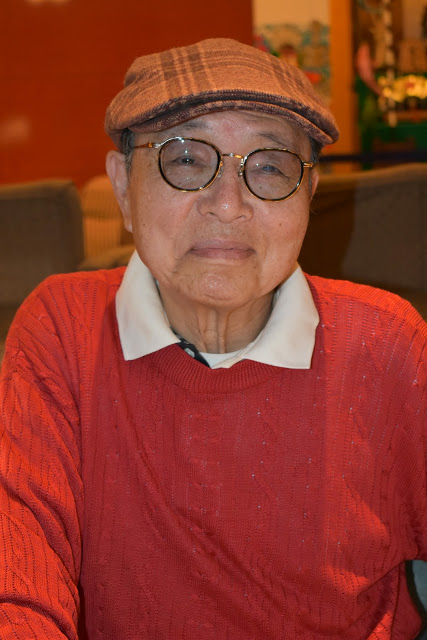
Shigemitsu Taguchi in April 2019. Photo © Brett Homenick.
Shigemitsu Taguchi is a television scriptwriter who shaped much of Tsuburaya Productions’ output during the 1970s. Born on February 4, 1944, Mr. Taguchi joined Tsuburaya Productions in the late 1960s, but officially began his career as a scriptwriter with the series Return of Ultraman (1971-72), which led to a successful career in tokusatsu. Mr. Taguchi wrote for many of Tsuburaya Productions’ TV programs around this time and served as the main writer for Ultraman Taro (1973-74) and Ultraman Leo (1974-75). In April 2019, Mr. Taguchi answered Brett Homenick’s questions in an interview translated by Makiko Nomoto.
Brett Homenick: Please talk about your early life in Nagano. For example, what were your hobbies? Where did you go to school?
Shigemitsu Taguchi: I made toy airplanes made of bamboo and flew them using rubber bands. I also bought toy model trains at the store and played with them. I made hydrogen gas by mixing sulfuric acid and lead and inflated the balloon with gas. I attached a small piece of paper to a string on the balloon to search for a friend. In my elementary school science class, we did this as a class project.
BH: Did anyone ever write back? Did this work?
ST: Never.
BH: Do you have anything else about your life in Nagano (that you’d like to share)?
ST: At my high school, I belonged to the mountaineering club. We climbed the Southern Alps and Central Alps. The Tenryu River flows between them. My birthplace is Iida, Nagano. The Southern Alps are to the east, and the Central Alps are to the west.
BH: Obviously, mountain-climbing can be difficult, so do you have any memories of seeing snakes or something interesting that stands out?
ST: I once saw a snake eat a big frog. I took a picture of it. There was also a mountain-climbing accident. In the autumn, the level of water in the rivers goes down. So we climbed a mountain along the river. One of the club members fell off a waterfall and died. It was 50 meters down. The water was low in the river, so when my friend fell, the impact was severe.
We cut down some trees and made a stretcher for him to carry him down from the mountain. On the way to the hospital, we made an emergency call, but when the doctor arrived at the mountain, my fellow club member had already died.
BH: Were there telephones in the forest that they could call?
ST: Another club member went down to the town and used a telephone there.
BH: At this time, when you were young, obviously it’s already a few years after the war. Life in Japan was difficult after the war. Did you feel any difficulties or hardships in the postwar time?
ST: I was born in 1944. I was born in Nagano Prefecture, and the town in which I grew up was a local area, so it was not damaged in the war. The local area had a lot of food available, such as apples and many kinds of vegetables. Some of the fathers of my classmates were killed in World War II.

Photo © Brett Homenick.
BH: Was your family affected?
ST: No.
BH: Let’s talk about going to university. Which did you go to, and why did you choose that university?
ST: I studied in the art department of Nihon University, specializing in movies. When I was a child, the only entertainment available was movies. So I went to see a movie every week.
BH: Do you remember any movies you watched that you enjoyed?
ST: I liked American Westerns. I saw a sci-fi movie called A Trip to the Moon about the exploration of the Moon. I also saw Godzilla.
BH: What was it like as a child to watch Godzilla in the theater? What was people’s reaction to Godzilla when it was new at the time?
ST: Nobody had ever seen a movie like that before, from adults to children. So we were very surprised. At the same, I was interested in how they made the movie.
BH: Please tell us how you joined Tsuburaya Productions.
ST: Tetsuo Kinjo’s friend was a student at my university. Mr. Kinjo’s friend introduced me to Tsuburaya Productions.
BH: At this time, did you have much knowledge of Eiji Tsuburaya? What did you think of this idea at first?
ST: I was interested in special effects. I wanted to become a screenwriter. At first, I was the second assistant special effects director on Ultra Seven.
BH: How did you get that job?
ST: The company wanted me to experience shooting on the set.
BH: When you did the work, please tell us what you had to do as the second assistant director (of special effects).
ST: I operated the clapperboard. I was the script supervisor (scripter) and kept track of the scene numbers. I also had to take care of the conditions for our actors. For example, I opened and closed the zippers on the monster suits. Because it was so hot inside the suits, the suit actors could suffocate. So I had to open the suits after every take. Moreover, the Ultra Seven suit actor wore the bottom half of his suit while carrying the top half in his arms.
I arranged the schedule because Ultra Seven and the monsters weren’t filmed every day. I helped other departments. For example, because they reflected light, I painted the piano wire that was used for the jets so that it wouldn’t reflect light.
BH: What color?
ST: The same color as the background.
BH: Around this time, did you meet Eiji Tsuburaya? If you ever met (him), what are your personal memories of meeting Eiji Tsuburaya?
ST: Mr. Tsuburaya had many visitors who tried to sell their ideas to him. For example, screenwriters and planners came to him with their ideas for projects. So Hajime Tsuburaya told me to be with Mr. Tsubuaraya. Eiji Tsuburaya was a nice and friendly person, and a little gullible, so Hajime Tsuburaya asked me to watch over and look out for him. Mr. Tsuburaya wanted me to watch out for suspicious or deceitful people.
BH: Did you find any suspicious people? What did you find?
ST: It depended on whether the people wanted to make more money than usual because such a person is suspicious. So I would find suspicious people who would try to cheat Mr. Tsuburaya. After that, I would report it to Hajime Tsuburaya.
BH: Generally speaking, what kind of personal memories do you have of Eiji Tsuburaya?
ST: He observed how a fly would move its legs, day after day.
BH: Why was he doing that?
ST: He observed the movements of insects because someday he might use them for monsters. He also like new things. For example, he liked new electrical appliances, such as washing machines and televisions. He bought them secretly, so his wife didn’t know about it. But when the bill was sent to his house, his wife found out about it.
BH: Did he get in trouble?
ST: (laughs) He spent a lot of money on that.
BH: Would he take them apart and study them? What would he do with these machines?
ST: He just liked new things. A neighbor would come over to his house to watch TV. He liked new media. Therefore, he made a new TV company. He was interested in what was getting popular, which is why he made a television company.
BH: I read that at the end of the 1960s, work at Tsuburaya Productions was starting to go down. Is that true?
ST: That’s true. The cost of production was increasing, and the cost of materials was going up, too.
BH: So what happened to you around this time?
ST: I was working at the planning section at Tsuburaya Productions, planning new special effects series.
BH: Let’s talk about work at the planning section. What did you do? How would you plan a new series?
ST: Ken Kumagai and Mr. (Kazuho) Mitsuta worked together on the same team. Akira Tsuburaya was there, too. We got unused scenes and edited them into new series called Ultra Fight. They were short episodes. I produced a 15-minute TV show for Nippon TV from Monday to Friday called Chibira-kun. It was by Tsuburaya Productions.
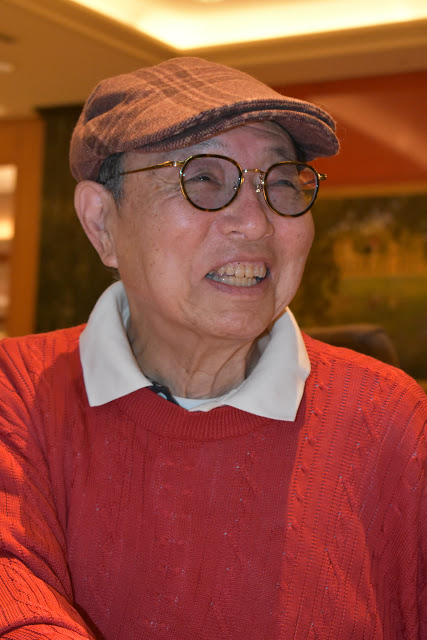
Photo © Brett Homenick.
BH: In the planning section, were there ever ideas that were rejected or not used that you can tell us about?
ST: Mr. Kinjo had left at that time. One of the reasons was high costs. Another was timing. When Hajime Tsuburaya returned to the company, he came up with the idea to collaborate with Shogakukan, which is a publishing company. At that time, Shogakukan was very popular. Its publications were selling very well. So by collaborating with Shogakukan, the opportunity to get sponsors would increase. So Tsuburaya Productions collaborated with Shogakukan. The result was Mirrorman.
BH: Were there any ideas for a new hero or a new TV show that were not used?
ST: We considered making a new Ultraman program twice a year, but this idea was never realized. The shows would have debuted in April and October. These are the usual times when TV programs change.
BH: But that was too expensive?
ST: TBS decided that it was not the best timing. At that time, the TV companies found sponsors, and TBS could not find sponsors for both Ultraman shows.
Tsuburaya Productions expected a profit from merchandising. When Hajime Tsuburaya returned to the company, we found that the company could profit from merchandising. (It was Hajime Tsuburaya’s idea.)
Also, that kind of collaboration had already proven to be successful. For example, Toei and Daiei had respectively worked together with Bandai. Toei had success with merchandising Kamen Rider, so we decided to do it, too.
BH: Which TV show was this? Mirrorman? Ultraman Ace? What was the first series where you used merchandising?
ST: Before Ultra Seven, Tsuburaya Productions had heavy debts. Because Fuji TV didn’t insist on getting a cut of the profits from merchandising, Tsuburaya Productions could keep all the profits. So after that, the company had no debt. During the tokusatsu boom (of the early 1970s), Tsuburaya Productions had a revival.
BH: Let’s talk about personal memories of Tetsuo Kinjo. What do you remember?
ST: He was like my older brother. We drank together many times. When Mr. Kinjo quit Tsuburaya Productions and returned to his hometown in Okinawa, he wanted to see snow because Okinawa never gets any. But Nagano Prefecture, which is where I’m from, gets a lot of snow. So we traveled to Nagano Prefecture together. We went to Lake Suwa. We stayed at a hot spring resort near Lake Suwa. At night, Mr. Kinjo got drunk and called several people who helped him during his career to thank them.
The next morning, he wanted to go bowling. Because he got drunk, he didn’t do well at bowling. On our way to the station, there was an antique shop. There was a trumpet in the shop, and Mr. Kinjo bought it. The shop owner told him that there was a famous story behind the trumpet. We didn’t know if the story was actually true or not, but Mr. Kinjo bought it. During the (Sino)-Japanese War, a Japanese soldier who was a trumpet player was shot but continued playing the trumpet. The shop owner told us that this trumpet was the real one from this story.
After he bought it, Mr. Kinjo played the trumpet every day. He got better and better at it as he played.
BH: Was he interested in trumpets at all, or was that just because it’s a famous story?
ST: I think it was just the owner’s joke, but Mr. Kinjo believed the story. When Mr. Kinjo returned to Okinawa, he played the trumpet to the people waving goodbye from Harumi Wharf in Tokyo. He thought that trumpet was the real one.
BH: Let’s talk about (Return of) Ultraman. I understand that there’s a story that producer Yoji Hashimoto asked for your help with Return of Ultraman.
ST: Mr. Hashimoto produced my debut script.
BH: How did you approach this? Talk about writing the script.
ST: I had to rewrite it until I got it approved. Mr. Hashimoto was a strict producer.
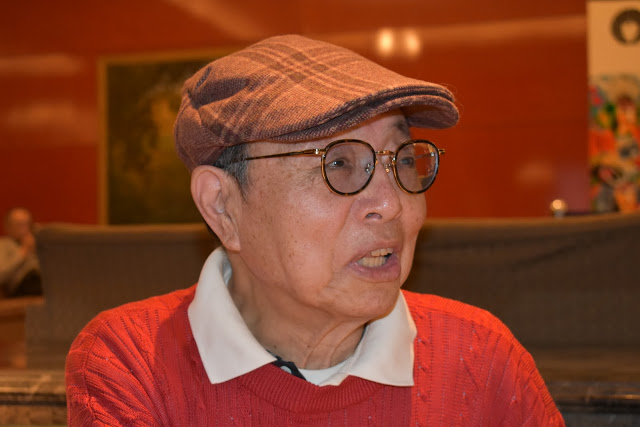
Photo © Brett Homenick.
BH: How many times did you (re-)write it?
ST: Several times — four or five.
BH: How long was that process?
ST: It was about a month.
BH: Working with Mr. Hashimoto, did you learn anything about screenwriting, or did you learn anything from Mr. Hashimoto about writing a script?
ST: Basically, I studied writing during my university days. But Mr. Hashimoto taught me the importance of writing the individual personality of each character.
BH: Do you have any general memories of writing for (Return of) Ultraman?
ST: After the director read the handwritten script, the producer would read it next, and then other staff members did, too. When they noticed something wrong, they would fold a corner of the page in the script. The director had his own corner of the script, and the producer had his own corner, and so on. So I would know who noticed something wrong on the page by which corner of it was folded. So during the reading of the script, I noticed when the corners were folded. Of course, I didn’t want any corners to be folded. I hoped no corners would be folded!
BH: Do you have any specific stories or anything in terms of the creative side about (Return of) Ultraman?
ST: I was thinking about Ultraman every day. (laughs)
BH: Was Ultraman Jack always supposed to be separate from the original Ultraman?
ST: They are different characters. Each Ultraman has a different face. The original Ultraman had five brothers. The chief of Shogakukan said to me, “For children, family is the most important thing.” So that inspired me to create the Ultra family.
BH: What general memories do you have of making Mirrorman and writing the show?
ST: Mirrorman was based on a memo that Mr. Kinjo wrote. Initially, Fuji TV had a plan to animate Pippi Longstocking, but they could not get the rights to the story. So as an alternative project to Pippi Longstocking, I rewrote the Mirrorman story based on Mr. Kinjo’s memo in just one night.
BH: How did you do that?
ST: I had already gotten most of the ideas for the outline of the story, so I wrote it in one night. The next morning, I brought it to the president of Otsuka Pharmaceutical Company. They were our sponsor, and it was approved.
BH: Do you have any general memories of writing for Mirrorman and the formula that you used for each episode?
ST: In the initial idea, there was another person on the other side of the mirror. However, we added a new idea — he can be transformed by looking at girls’ tears, which is a bit of a romantic idea. Also, Mirrorman’s mother was a Japanese woman, and his father was a man from another mirror world.
BH: Were there ever any plans to follow up Mirrorman with another show?
ST: There was never such an idea.
BH: Why did two characters from Mirrorman appear in Jumborg Ace?
ST: I made the characters of Jumborg Ace. I always planned the characters.
BH: What memories do you have of working on Ultraman Ace?
ST: Shinichi Ichikawa, Shozo Uehara, and I stayed in a hotel to create the story, and it was based on the ideas of the three of us. The most important idea was the combined change of the male and female heroes.
BH: Whose idea was that?
ST: It was Mr. Ichikawa’s.
BH: What was your idea?
ST: I don’t remember! (laughs)
BH: Do you remember Mr. Uehara’s idea?
ST: It was almost the same as the previous shows. There would be a monster.
BH: How long were you in the hotel together?
ST: For three days.
BH: How did you get along with Mr. Uehara and the other writers? Did you get along well? Was there conflict?
ST: There was no conflict.
BH: When it came to writing the series later on, do you have any other memories of writing Ultraman Ace?
ST: We had to do the combined change (with the two heroes) every time. That was difficult.
BH: Why was Minami (the female half of Ultraman Ace’s human hosts) from the Moon?
ST: At first, she was not from the Moon. As I said, the combined changed was difficult. Because the two characters had to be together, it was difficult. So that’s why Minami was from the Moon, and went back there. Thus, Hokuto (Ultraman Ace’s male host) was able to change by himself, which made the story less difficult.
BH: Then Minami eventually left the show. So it was just one character. Could you talk about the process of writing Minami out of the show?
ST: The combined change was difficult, so we made it so that only one of the characters could change into Ultraman Ace.
BH: What memories do you have of writing Jumborg Ace?
ST: Mainichi Broadcasting System (MBS) in Osaka asked me to work together with them. We met at a hotel in Akasaka. The agreement was made quickly.
BH: Let’s talk about the creative side of writing Jumborg Ace.
ST: The idea was that man and machine combine. Jumborg Ace was based on that idea. The plane changes into the hero. In other programs, there was already a team. But on Jumborg Ace, the team was finished in the first episode. Although other shows had teams, we decided not to do that for Jumborg Ace and base the show around only one hero.
BH: Let’s also talk about Ultraman Taro. For this show, you’re the main writer. How did you get the job as the main writer for Ultraman Taro?
ST: Because the ratings were decreasing, I thought Ultraman Taro would be the final Ultraman series. So we made the story like a fairy tale, something like Arabian Nights. The name Taro is the main character of a Japanese fairy tale. So I named him Ultraman Taro.
BH: Were all the writers and staff members OK with that, or did some people think it was too silly?
ST: Everyone agreed with it.
BH: Do you have general memories of writing the scripts? As the main writer, how did your work change from previous jobs?
ST: Mr. Hashimoto decided that the main writer would write the first and last episode of a series.
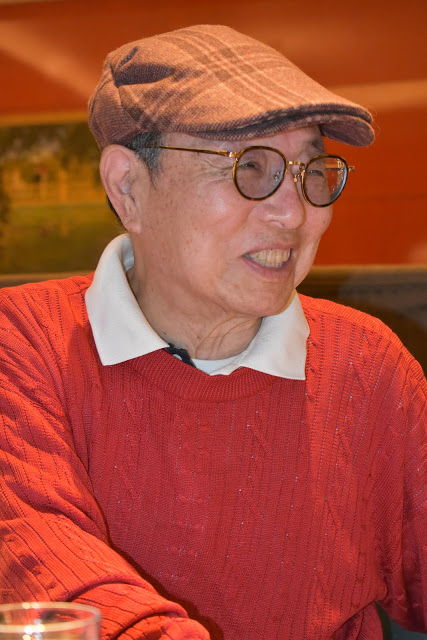
Photo © Brett Homenick.
BH: Why was Taro not with the other Ultra Brothers in Ultraman Leo?
ST: The wife of Saburo Shinoda, who played the main character in Ultraman Taro, told him that if he continued in the Ultra-series or other tokusatsu programs, he could not appear in more serious TV programs as an actor. So his wife did not want him to appear in the Ultra-series anymore.
BH: In the last episode of Taro, why did Kotaro (Ultraman Taro’s human host) leave behind his life as a superhero?
ST: He returned to human life because I thought Taro would be the final Ultra-series. So Kotaro went back to being a human.
BH: Why did the series continue? Why was Ultraman Leo made?
ST: Although the ratings were decreasing, TBS wanted to continue with another series. So I thought the next series should have more action. The main character from Ultra Seven (Dan Moroboshi) trained the young hero of this series.
BH: Did you name Ultraman Leo?
ST: We created the name in a collaborative effort. We wanted a name that suggested a lion.
BH: Let’s talk about the creative process. Where would you get inspiration and ideas for stories?
ST: From my mind. (laughs)
BH: For the Ultra-series in general, how long would it take to write one episode?
ST: It would usually take five or six hours to write. I about wrote 60 pages with 200 letters on each page in about three to six hours. But the whole process, including rewrites, took two days.
BH: How many pages was that, usually?
ST: Between 65 and 70 pages.
BH: If we go back to (Return of) Ultraman episode 8, you said it took a month to rewrite that script.
ST: It was my debut! (laughs)
BH: After Ultraman Leo, was there any (consideration) to keep it going?
ST: TBS decided.
BH: Out of (Return), Ace, Taro, and Leo, which is your favorite?
ST: Taro.
BH: Which is your least favorite?
ST: Leo.
BH: Why?
ST: There are too many action scenes. There is not enough drama. Too many scenes were comprised of action scenes.
BH: Why do you like Taro the best?
ST: Taro is less violent and like a fairy tale, so I think it suited me because that’s my character. I enjoyed writing Taro.
BH: Around this time, Tsuburaya Productions worked with Chaiyo, a Thai company. This caused many problems because there was a lawsuit with Chaiyo and Tsuburaya Productions over the rights of Ultraman. Did you have any dealings with Chaiyo?
ST: No, I didn’t.
BH: After Ultraman, there were three Tsuburaya series: (Dinosaur Expedition) Born Free, (Dinosaur War) Izenborg, and (Dinosaur Corps) Koseidon. These matched anime and live action. Was it difficult to match anime and live action? It’s a very unusual process. Talk about writing a series that way.
ST: It was no different.
BH: Do you have any memories of the creative of these shows?
ST: For Koseidon, Masaki Tsuji made the plan. It went beyond spacetime. The director, Mr. (Toru) Toyama, and I went to Nagano Prefecture to scout locations.
BH: Of the three series, Born Free, Izenborg, and Koseidon, which do you think was the best?
ST: It’s Born Free because of the idea of protecting the animals was good. The plan was developed by Mr. Sueyasu in the sales department of Tsuburaya Productions.
BH: Do you remember working on Born Free and any stories that you wrote?
ST: There is nothing special.
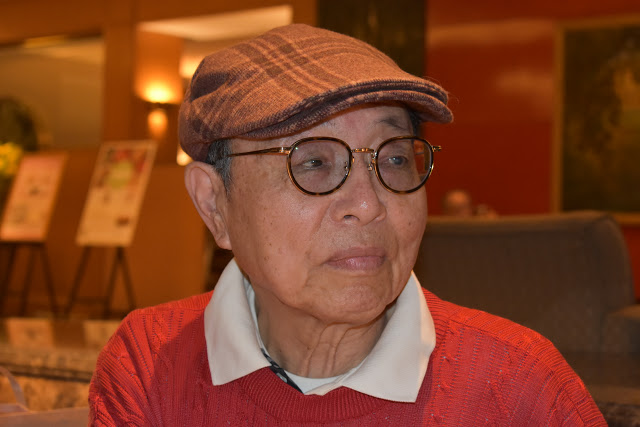
Photo © Brett Homenick.
BH: The last show we’ll talk about is Ultraman 80. What do you remember about working on Ultraman 80?
ST: The main character was a teacher. When the monster appeared during class, it was a creative problem. It was very difficult because if the monsters appeared during class, the teacher had to become Ultraman, which would reveal his true identity to the students. So I wrote it so that the monsters would not appear during class.
If we follow the premise of the Ultraman series, the teacher has to keep it a secret that his real identity is Ultraman. If I had written the story, I wouldn’t have set it that way. If I had written the story, my idea would have been to make all the students know his true identity. Then all the students would have supported the teacher.
BH: In the series, of course, the teacher joined a team. They changed the story. Is that why — because it was too difficult to write the teacher as a secret Ultraman?
ST: I’m not sure, but I think so.
BH: How did you feel about Ultraman 80? Do you think it was a good TV show, or maybe not so good?
ST: Mr. (Shosuke) Ai was a conservative person. He also worked on Ultraman Ace. He was a disciple of Mr. (Toshiro) Ishido.
BH: Do you know why 80 was made? There was a five-year gap (before 80 was made). Then after that, there was like a 10-year gap.
ST: Tsuburaya Productions was having some problems. The Tsuburaya family doesn’t have stock in the company anymore. The policy of Tsuburaya Productions has changed. Using miniatures costs more than using CG.
TBS thought it was about time for a new Ultra-series. I don’t know why there was a gap after Ultraman 80.
BH: Throughout the Ultra-series, there were many directors like Mr. (Eizo) Yamagiwa, Noriaki Yuasa — many directors. Did you have any memories of the directors that you worked with?
ST: I worked with Mr. Yamagiwa when I was a beginner, so Mr. Yamagiwa taught me movie logic. I didn’t work with Mr. Yuasa. When Hajime Tsuburaya hired Ishiro Honda as the director of the first episode of Return of Ultraman, he said, “He is the director of Godzilla.” It added quality to the production.
BH: How about memories of Hajime Tsuburaya?
ST: Hajime Tsuburaya picked me up in the morning from my home. So he was like my manager. I stayed with Hajime Tsuburaya during the day. After work, we went drinking together, and then he took me home. Then he picked me up again in the morning. (laughs)
BH: Why do you think Hajime Tsuburaya was so close to you?
ST: (laughs) I think Hajime Tsuburaya and I got along very well. When I was in the planning section, Mr. Tsuburaya allowed me to plan and develop new programs. I created a TV show called Single Man’s Skat (1969).
BH: Why did you (create that program)?
ST: Because the sponsor was Shiseido (a cosmetics company), I wanted to create a stylish comedy, so that’s why it was based on the movie The Apartment. It was a one-set drama.
Special thanks to Connor Anderson.